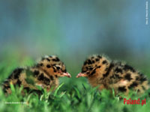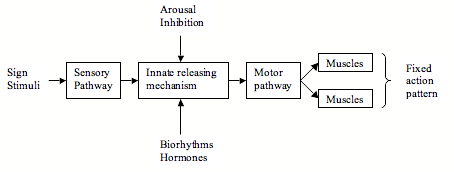Eggshell Removal in Shorebirds
Biology 342 Fall 06
By Molly & Jennifer
| Home | Mechanism | Ontogeny | Phylogeny | Adaptive Value | References | 2006 websites |
Mechanism
Neural Mechanism
The neural mechanisms involved must be simple for the eggshell removing behavior to be swift (Simmons & Young, 1989). The eggshell removal is considered an
anti-predation behavior, and is performed very soon after a chick
hatches. For example, Common Black-headed Gulls normally remove
the eggshells within a couple of hours after chicks hatch, and
sometimes within minutes. The shorebirds must remove empty
eggshells and return to their nests quickly to protect their chicks
from predators; there is no time for elaborate neural processing to operate.
Two Black-headed Gull chicks
Eggshell removal is an example of a “Dedicated System”, which is a system that is largely devoted to a single important function such as escape. The single important function of eggshell removing behavior would be Anti-predation. Since the system is dedicated to one function, the number of nerve cells involved in this mechanism is small (Simmons & Young, 1989).
Genetically Programmed Behavior Mechanism: Instinct
Eggshell removal is an instinctive behavior in shorebirds. Research has shown that the first time breeders will remove the empty shells placed in their nests even before they lay their first egg. This suggests that the eggshell removing behavior is programmed in their genes – it is not a learnt behavior.Below is a flow diagram showing early ethological concepts of the mechanisms involved in a simple behavior pattern such as egg retrieval (Simmons & Young, 1989).
Figure 1. Flow diagram demonstrating the early ethological concepts of the mechanisms involved in a simple behavior pattern.
Stimulus-Response Mechanism
The flow chart above clearly outlines the stimulus-response mechanism of a simple behavior pattern.Important Stimulus: Eggshell Color
Tinbergen experimentally found that color is a crucial stimulus for the
eggshell removal behavior. In particular, the Common Black-headed
Gulls tended to remove orange colored eggshell models the most, among
other unnatural eggshell colors such as blue and green. Also, the
birds tended to remove eggs that appeared similar to their own –
white inner lining.Perceptual Mechanisms
D. Max Snoddely Jr. (1978) suggested from his experimental findings that the eggshell removal behavior could be elicited via different perceptual mechanisms: Contrast and Recognition Mechanisms. Contrast Mechanism is stimulated by a broad range of foreign objects that contrast with the nest background. Recognition Mechanism is a system that specifically recognizes the eggshell.D. Max Snoddely Jr. found that in the laughing gulls, the Contrast Mechanism appeared to be at least as strong as the Recognition Mechanism. In other words, the eggshell removing behavior of the laughing gulls was more dependent on the color of the eggshells than their shape.
Other Stimulus: Eggshell Weight
Tinbergen found through his experiment that the eggshell removal behavior of Common Black-headed Gulls is Weight-Dependent.To investigate how the gulls differentiat between an egg, a half-hatched chick, and an empty eggshell, Tinbergen conducted series of tests using modified eggs – blown eggs with the shells intact but empty; blown eggs with additional flanges of broken eggshells glued to them; eggshells open and filled with either plaster or cotton wool; and eggshells open and filled with lead, weighing as much as a chick.
He found that the gulls disposed all eggs except those that weighed as much as a chick. He observed that if a gull started to pick up a shell containing a lead weight in it, it stopped immediately and put it back down. Not a single “chick-weighted” shell was removed and disposed from the nest. This suggests that the weight of an egg is an important factor that determines the eggshell removing behavior.
